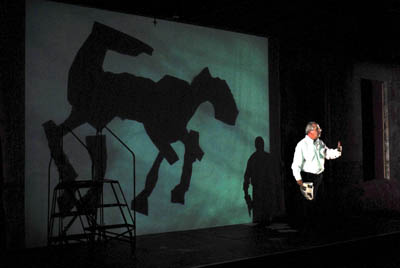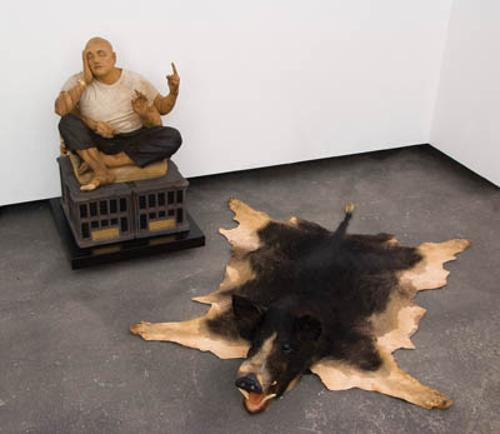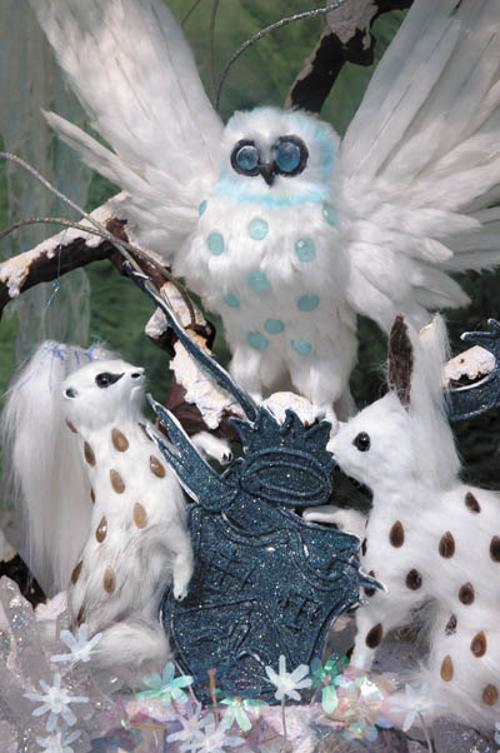
There's something about performance art that makes me inherently nervous. The high stakes vulnerability of the artist in the face of failure, the unspoken expectation that you will sit there and commit to the duration of the work when you would otherwise saunter on to the next piece if you didn't get it/didn't like it/didn't want to. And let's not talk of a latent fear of unwitting participation&
So it has been interesting then to approach the 2008 Sydney Biennale from the angle of its performative work. Throughout the biennale and across all of its venues performance figures regularly, as one-off events, ongoing programs and workshops, even a sausage sizzle. A number of historically significant performance art works, such as Carolee Schneeman's Meat Joy and Mike Parr's Hold your finger in a candle flame for as long as possible also feature, though via video documentation rather than through any sort of re-creation. It's a mishmash of old and new and as to be expected, some pieces are more effective than others, particularly when it comes to locating them within the context of the Biennale's theme Revolutions – Forms That Turn.
Perhaps one of the most successful works – certainly one of the higher profile performances, was Spanish artist Dora Garcia's Just Because Everything is Different Does Not Mean Anything Has Changed. An artistic re-imagining of the thwarted 1962 performance of American comedian Lenny Bruce, whose now famous arrest for obscenity bears an unsettling familiarity to the recent hysterics over Bill Henson and Polixeni Papapetrou, Just Because Everything is Different is a thought-provoking and compelling examination of the power of language and what it means to be obscene. Based on spliced together audio-recordings of past Bruce performances with a mix of contemporary references and reflections, Garcia's Bruce argues that obscenity is a human manifestation and that society's suppression of a word is what gives it its power and violence, saying: 'You [the audience] are the ones that arrested me. You are the lawmakers, not the police. You think because you all go surfing in your lunch hour that you're all so open-minded.' Touché.
There's perhaps an expectation that a re-imagined performance by a comedian would be laugh-out-loud funny. This wasn't necessarily the case but even 40 years later, despite the nostalgic dating of much of the humour, there is still a bite to Bruce that remains scarily relevant and jokes about Jews, niggas, micks and spicks are still nervously received, despite Bruce's not unreasonable musing on what would happen to the word nigga if a carefree President Obama started throwing the word around, referring to his Senate, the American people, Congress& as 'my niggas'. It's a fascinating thought.
Just Because Everything is Different is arguably more theatre than performance art but nonetheless it's a fascinating prod at those invisible social mores and boundaries of perceived moral propriety and one that challenges us to liberate our language and our thinking.
Joan Jonas's Reading Dante is materially and aesthetically miles from Garcia's Opera House performance. A founding figure of video and performance art, Jonas has been working in performance for four decades and Reading Dante amalgamates all her interests across video, sculpture, performance, sound and masquerade. The references to Dante's poems The Inferno and Paradiso may have been explicit, I'm not sure, there certainly wasn't a linear narrative to speak of but the aesthetics and the exquisite use of masks, fragmented video screens, shadows, chalk and tracing paper, and an accoutrement of found objects as instruments made it at the very least a fascinating and contemplative visual exercise.
Much has been made of Mike Parr's inclusion in this year's Biennale and the retrospective nature of video documents of a number of his performance works from the last several decades. A self-proclaimed pacifist, Parr's performances are by turns so confronting, disturbing, violent and nausea-inducing it's hard to look past the gratuity of his actions, whether he's stitching his face in protest at the treatment of refugees, or dropping a lit match onto his stomach, to appreciate the saliency of his intentions. There's certainly wit amid the violence, the artist sick of art vomiting paint, and a profoundly sad and deep sense of shame at a country that treats its refugees with such contempt, but the overwhelming and unfortunately more lingering impression is a purely sensory one. Add to a violence-induced nausea the deliberately retained smell of shit from the old sewers of the dilapidated sailor's quarters that house Parr's works and you can not help but be relieved to exit the building. And I'm not sure that's the point.
There's a clever joke somewhere waiting to be written that involves Schneeman's iconic orgiastic 1964 performance Meat Joy and Tony Schwensen's art event-cum-barbeque Fundrazor (Fuck You Pay Me) or Who Gets to Sit at the Pointy End of the Plane? I'm not sure what the joke is, but it's out there and it's not for vegetarians. Schwensen's fry-up on the lawn fronting the MCA was a tongue-in-cheek attempt to raise funds for artist projects for the 2010 Biennale. Perhaps an exercise in community building rather than art-making (though he does sizzle a mean sausage), Schwensen's event, like Stuart Ringholt's free anger workshops at the Art Gallery of New South Wales are something of an anomaly, falling as they do outside the conventional parameters of the art-viewing experience. Essentially experiential works, impermanent, reactive, and uncertain, the 'art' is more in the thought, the process and the experience. How memorable they will prove to be remains to be seen but there's something quite beguiling about a biennale with such highly visible artists, performing, workshopping, lecturing, offering personalised mystery tours or even handling a pair of barbeque tongs.
The performative work of this Biennale, and there is more of it than is mentioned here, offers a range of entry points into discussions of high art, performance art and even revolutions to a point. Reviewed in isolation this body of work might seem disjointed and ad hoc but within the wider experience of the Biennale it offers a dynamic and literally very real opportunity to engage with the art-making process.












